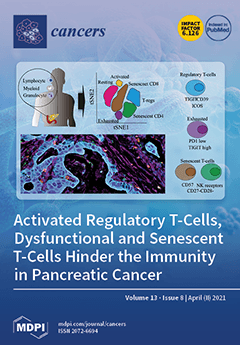Gemcitabine-docetaxel (G-D) combination is an effective chemotherapy for patients with advanced soft tissue and bone sarcoma, first developed with G administered on days 1 and 8, and D on day 8 every 21 days and later modified to be administered every 14 days
[...] Read more.
Gemcitabine-docetaxel (G-D) combination is an effective chemotherapy for patients with advanced soft tissue and bone sarcoma, first developed with G administered on days 1 and 8, and D on day 8 every 21 days and later modified to be administered every 14 days in 2012. The 14-day regimen has become increasingly adopted. However, its efficacy and toxicities have not been compared. We identified 161 patients with metastatic or locally advanced soft tissue and bone sarcoma treated with either a 14-day or 21-day regimen within Northern California Kaiser Permanente from 1 January 2017 to 30 July 2020 and compared the outcomes and toxicity profiles of patients treated with the either regimen. Seventy-nine (49%) and 82 (51%) patients received the 14-day and the 21-day regimen, respectively, with similar response rate (22.8% and 15.8%,
p = 0.26), median progression-free survival (PFS, 4.0 and 3.2 months,
p = 0.15), and median overall survival (OS, 12.6 and 14.7 months,
p = 0.55). Subset analysis of the untreated patients (approximately 60% of the entire cohort) as well as the patients with leiomyosarcoma only (approximately 50% of the entire cohort) showed that OS was not significantly different between the two regimens. Febrile neutropenia requiring hospitalization occurred in 10 and one patients (
p = 0.006) and intolerance leading to discontinuation of chemotherapy occurred in 12 and two patients (
p = 0.006) treated with the 21-day and the 14-day regimens, respectively. CDKN2A deletion/mutation or CDK4 amplification was associated with worse median OS (
p = 0.06), while a RB1 deletion/mutation was associated with better median PFS (
p = 0.05), and these two genomic alterations were mutually exclusive. Our data demonstrate that, compared to the traditional 21-day G-D regimen, the 14-day G-D regimen is equally effective but safer. In addition, CDKN2A and RB1 pathways play significant role on the outcomes of the patients.
Full article






